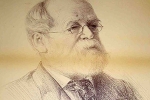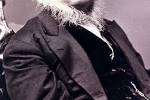Boyhood Friends, Journalistic Rivals.
Horace Greeley was born in Amherst, New Hampshire, in 1811. He came to Poultney to apprentice at the Northern Spectator newspaper in East Poultney from 1826 to 1830. The paper was published in a print shop built on the green in 1823. This building, commonly known as the Horace Greeley House, now houses Picket Fence Antiques.
Though Greeley worked in this house, he never lived there. During his time in Poultney, he boarded first at the home of the paper’s editor E.G. Stone and later at the Eagle Tavern, then owned by Harlow Hosford. He was well regarded for his intelligence, his factual knowledge of current events and his debating skills. He quite probably wrote the obituary for former Poultney resident Jeffrey Brace in 1827.
Greeley left Poultney at the age of 19 for New York City, where he became editor of several publications and in 1841 founded the New York Tribune.
George Jones was born in East Poultney in 1811, the son of John Jones, who managed and then owned a woolen mill  one mile upriver (east) from the East Poultney Green. His family moved to Granville, Ohio, in 1823 and shortly afterwards, George Jones was orphaned at the age of 13. He returned to Poultney to live with his brother John Jones, Jr. He supported himself though work in the general store of Amos Bliss, who also owned the Northern Spectator, and became friends with a fellow employee, Horace Greeley.
one mile upriver (east) from the East Poultney Green. His family moved to Granville, Ohio, in 1823 and shortly afterwards, George Jones was orphaned at the age of 13. He returned to Poultney to live with his brother John Jones, Jr. He supported himself though work in the general store of Amos Bliss, who also owned the Northern Spectator, and became friends with a fellow employee, Horace Greeley.
The 15-year-old friends were together on the East Poultney Green for festivities celebrating the 50th anniversary of the Declaration of Independence in 1826.
Jones left Poultney in 1833 and over the next 18 years acquired experience in banking, book publishing and the newspaper businesses. He also formed a close friendship with Henry Raymond, whom he met while both were employees at Greeley’s New York Tribune. The two founded the New York Times in 1851. Jones concentrated on the financial and business aspects of the paper while Raymond served as editor. Together they made the Times a very successful paper.
As editor of the New York Tribune, Greeley advocated reform in many spheres, supporting temperance, Transcendentalism, and labor unions. In the 1840’s he urged a generation to “Go west, young man.” Originally a Whig, in 1856, he wrote an editorial supporting the creation of the Republican Party. In 1872 he ran for President of the United States as a Democrat against the Republican candidate, Ulysses S. Grant. Harper’s Weekly in 1869 called Horace Greeley “the most perfect Yankee the country has ever produced.”
In 1869, upon the death of Henry Raymond, George Jones became the editor of the Times. In this role Jones was to lay the ground work for the journalistic integrity of the newspaper. He insisted on a buffer between the advertising and business side and the editorial and reporting side of the newspaper. He honored this policy in several important instances.
In 1870, the Times uncovered evidence that Tammany Hall Boss William Marcy Tweed was diverting public funds for personal use. The Times launched an editorial attack on Tweed and his accomplices and persisted in the attacks despite the loss of advertising income from the city of New York and lack of editorial support from other papers. The effort ultimately led to the defeat of Tammany Hall.
In 1884, Jones ““ a staunch Republican and firm Grant supporter ““ could not on principle support the Republican candidate Blaine and eventually endorsed the Democratic candidate for President, Grover Cleveland. Cleveland won, and the Times again suffered a temporary loss of advertising income. These remarkable displays of courage established the integrity of the New York Times.

